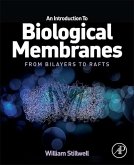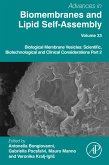1. Introduction and overview of the book
Part 1: Building blocks and the shape builders 2. Membrane lipid
compositions and the difference between subcellular structures 3.
Wiskott
4. BAR domains 5. Ankyrin repeat domains with an amphipathic helix for
membrane deformation 6. Ankyrin repeat domains 7. Dynamin: molecular
scissors for membrane fission 8. Phospholipid signaling, lipase 9.
Phospholipid signaling: phosphoinositide kinases and phosphatases 10.
Plasma membrane shaping by protein phase separation 11. Synthetic mimics of
membrane-active proteins and peptides
Part 2: The functions of the plasma membrane substance and derived vesicles
12. The extracellular vesicles 13. Regulation of membrane traffic through
recycling endosomes by membrane phospholipid phosphatidylserine 14.
Membrane shaping for clathrin-coated pits and endocytosis 15. Caveolae
biogenesis and lipid sorting at the plasma membrane 16. Non-vesicular lipid
transport at membrane contact sites between the endoplasmic reticulum and
the plasma membrane 17. Lamellipodia and filopodia 18. Membrane structures,
dynamics, and shaping in invadopodia and podosomes
Part 3: Force around the plasma membrane and imaging 19. Membrane tension
and mechanobiology of cell migration 20. Brownian ratchet force sensor at
the contacting point between F-actin barbed end and lamellipodium tip
plasma membrane 21. Biophysics of cellular membrane shaping on fiber
networks 22. Reconstitution of membrane symmetry breaking
Part 4: The microscopy and image analysis for understanding the shaping of
the membrane 23. Imaging three-dimensional dynamics of plasma membrane
structures using ultrathin plane illumination microscopy 24. Deep learning
for cell shape analysis
Part 5: The essentiality of the membrane shaping by theory and
reconstitution 25. Physical principles of cellular membrane shapes 26.
Modeling cellular shape changes in the presence of curved membrane proteins
and active cytoskeletal forces 27. Molecular dynamics









